Perkenalan
Selecting the right equipment for your construction or drilling project is crucial to ensure efficiency, cost-effectiveness, and safety. A hydraulic rotary drilling rig is an essential piece of machinery in various drilling applications, including construction, mining, and geothermal projects. Understanding the key features and considerations when choosing the best hydraulic rotary drilling rig for your project can significantly impact your operation’s success. This comprehensive guide will help you navigate through the selection process, highlighting critical factors and providing practical insights to make an informed decision.
Understanding Hydraulic Rotary Drilling Rigs

What is a Hydraulic Rotary Drilling Rig?
A hydraulic rotary drilling rig is a machine used for drilling boreholes in the earth. It employs hydraulic pressure to power the rotary drilling process, which involves rotating a drill bit to cut through soil, rock, and other subsurface materials. These rigs are known for their efficiency, versatility, and ability to handle various drilling tasks, making them indispensable in many industries.
Applications of Hydraulic Rotary Drilling Rigs
Hydraulic rotary drilling rigs are used in a wide range of applications, including:
- Konstruksi: Foundation drilling, pile installation, and soil stabilization.
- Pertambangan: Exploration and extraction of minerals.
- Geothermal Energy: Drilling wells for geothermal heating and cooling systems.
- Oil and Gas: Exploration and production of oil and gas reserves.
- Water Wells: Drilling wells for water supply.
Key Components of a Hydraulic Rotary Drilling Rig
Understanding the key components of a hydraulic rotary drilling rig can help you evaluate different models and choose the best one for your needs. The main components include:
- Drill Mast: The vertical structure that supports the drill string and other equipment.
- Drill Bit: The cutting tool at the bottom of the drill string.
- Rotary Table or Top Drive: Mechanisms that provide the rotational force to the drill bit.
- Hydraulic System: Powers the rig and provides the necessary pressure for drilling operations.
- Control Panel: Allows the operator to control and monitor the drilling process.
- Mud Pump: Circulates drilling fluid to lubricate the drill bit and carry cuttings to the surface.
Factors to Consider When Choosing a Hydraulic Rotary Drilling Rig
Persyaratan Proyek
The specific requirements of your project are the most important factors to consider when choosing a hydraulic rotary drilling rig. These requirements include:
- Depth of Drilling: The depth to which you need to drill will determine the type and size of the rig required.
- Soil and Rock Conditions: Different rigs are designed to handle various soil and rock conditions. Consider the geological conditions of your project site.
- Diameter of Boreholes: The diameter of the boreholes you need to drill will influence the choice of drill bit and rig.
- Type of Drilling: Different drilling methods, such as reverse circulation or directional drilling, may require specific rig features.
Rig Specifications
Evaluate the technical specifications of the rig to ensure it meets your project needs. Key specifications to consider include:
- Drilling Depth Capacity: The maximum depth the rig can drill.
- Rotary Torque: The rotational force provided by the rig, measured in foot-pounds or Newton-meters.
- Hydraulic Pressure: The pressure generated by the hydraulic system, measured in pounds per square inch (psi) or bar.
- Power Source: The type of power source, such as diesel or electric, and its capacity.
Mobility and Transport
Consider the mobility and transportability of the rig, especially if your project involves multiple sites or remote locations. Factors to evaluate include:
- Rig Weight and Size: Ensure the rig can be transported easily and fits within the constraints of your project site.
- Crawlers or Wheels: Depending on the terrain, choose a rig with appropriate mobility options.
- Setup and Teardown Time: Consider the time and effort required to set up and dismantle the rig.
Kenyamanan dan Keamanan Operator
The comfort and safety of the rig operators are crucial for efficient and safe operations. Look for features such as:
- Ergonomic Controls: Easy-to-use and well-placed controls to reduce operator fatigue.
- Fitur keamanan: Emergency shut-off, fail-safe systems, and protective barriers.
- Visibility: Good visibility from the operator’s cabin or control station.
Cost and Budget
Balancing the cost and your budget is essential when choosing a hydraulic rotary drilling rig. Consider both the initial purchase price and the ongoing operational and maintenance costs. Factors to evaluate include:
- Purchase Price: The initial cost of the rig.
- Operational Costs: Fuel, hydraulic fluid, and other consumables.
- Maintenance Costs: Regular servicing, spare parts, and repairs.
- Resale Value: Potential resale value of the rig after the project completion.
Comparison between hydraulic rotary drill and other rotary drills
| Feature | Hydraulic Rotary Drill | Other Rotary Drills |
|---|---|---|
| Power Source | Hidrolik | Electric, Pneumatic, Diesel |
| Drilling Method | Putar | Rotary, Percussive, Impact |
| Torque | High | Variable depending on type |
| Drilling Depth Capacity | High | Variable depending on type |
| Mobility | Typically mounted on tracks or wheels | Portable or mounted on vehicle |
| Applications | Construction, Mining, Geothermal | Construction, Mining, Geotechnical |
| Control | Hydraulic control systems | Electric or pneumatic controls |
| Pemeliharaan | Regular hydraulic system maintenance required | Variable maintenance depending on type |
| Biaya | Higher initial cost, lower operational costs | Variable depending on type and features |
Maintenance and Safety Tips for Hydraulic Rotary Drilling Rigs
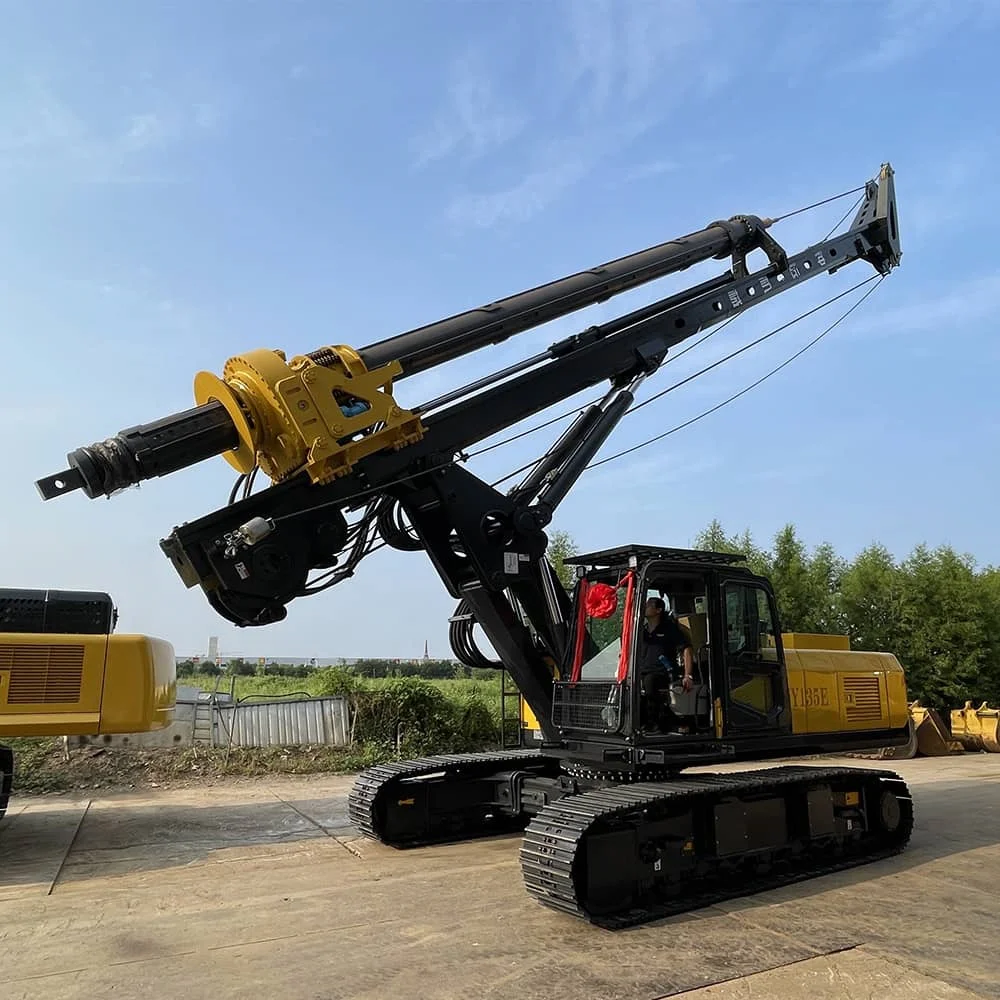
Regular Maintenance
Regular maintenance is crucial to ensure the longevity and efficient performance of your hydraulic rotary drilling rig. Key maintenance practices include:
- Inspeksi Harian: Check for any signs of wear and tear, leaks, or other issues.
- Lubrication: Regularly lubricate moving parts to reduce friction and wear.
- Hydraulic Fluid Levels: Monitor and maintain appropriate hydraulic fluid levels.
- Penggantian Filter: Replace filters as recommended by the manufacturer.
- Scheduled Servicing: Adhere to the manufacturer’s recommended servicing schedule.
Safety Guidelines
Safety is paramount when operating a hydraulic rotary drilling rig. Follow these safety guidelines to protect operators and other personnel:
- Training: Ensure all operators are adequately trained and certified.
- Alat Pelindung Diri (APD): Provide and enforce the use of appropriate PPE, such as helmets, gloves, and safety glasses.
- Prosedur darurat: Establish and communicate clear emergency procedures.
- Machine Guards: Ensure all machine guards are in place and functional.
- Pertimbangan Lingkungan: Be mindful of environmental regulations and ensure proper handling of hazardous materials.
Kesimpulan
Choosing the best hydraulic rig pengeboran putar for your project involves careful consideration of various factors, including project requirements, rig specifications, mobility, operator comfort, and cost. By understanding the key components and applications of hydraulic rotary drilling rigs, you can make an informed decision that will enhance the efficiency and success of your drilling operations. Regular maintenance and adherence to safety guidelines will ensure the longevity and safe operation of your rig, ultimately leading to a successful project outcome.
Pertanyaan Umum
What is a hydraulic rotary drilling rig?
A hydraulic rotary drilling rig is a machine used for drilling boreholes in the earth. It employs hydraulic pressure to power the rotary drilling process, making it efficient and versatile for various applications, including construction, mining, and geothermal projects.
What factors should I consider when choosing a hydraulic rotary drilling rig?
Key factors to consider include project requirements, rig specifications, mobility, operator comfort, safety features, and cost. Understanding these factors will help you choose a rig that meets your needs and enhances the efficiency of your operations.
How does a hydraulic rotary drilling rig improve project efficiency?
Hydraulic rotary drilling rigs improve project efficiency by providing powerful and precise drilling capabilities, reducing downtime, and enhancing the overall quality of the boreholes. Their versatility and ability to handle various geological conditions also contribute to improved project outcomes.
What are the common applications of hydraulic rotary drilling rigs?
Common applications include foundation drilling, pile installation, soil stabilization, mineral exploration, geothermal well drilling, oil and gas exploration, and water well drilling. These rigs are versatile and can be adapted to various drilling tasks.
How can I ensure the longevity and safe operation of my hydraulic rotary drilling rig?
Regular maintenance, including daily inspections, lubrication, hydraulic fluid monitoring, filter replacement, and scheduled servicing, is crucial. Additionally, following safety guidelines, providing operator training, and using appropriate personal protective equipment will ensure safe and efficient operation.

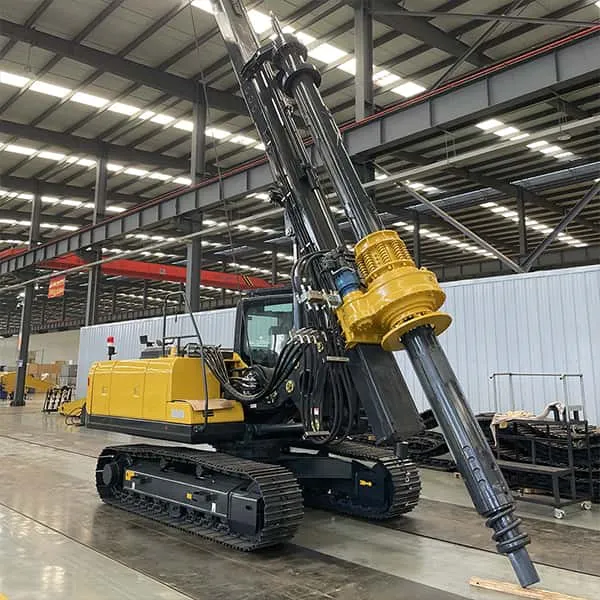
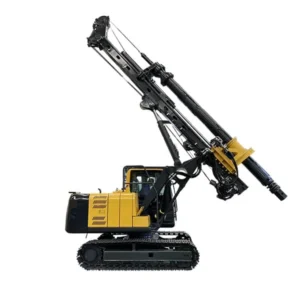
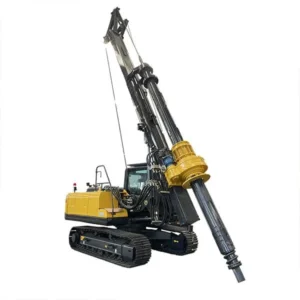
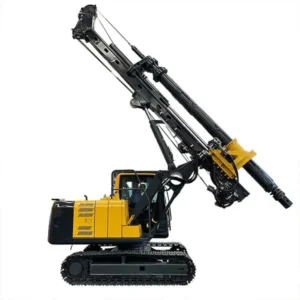




-150x150.webp)
